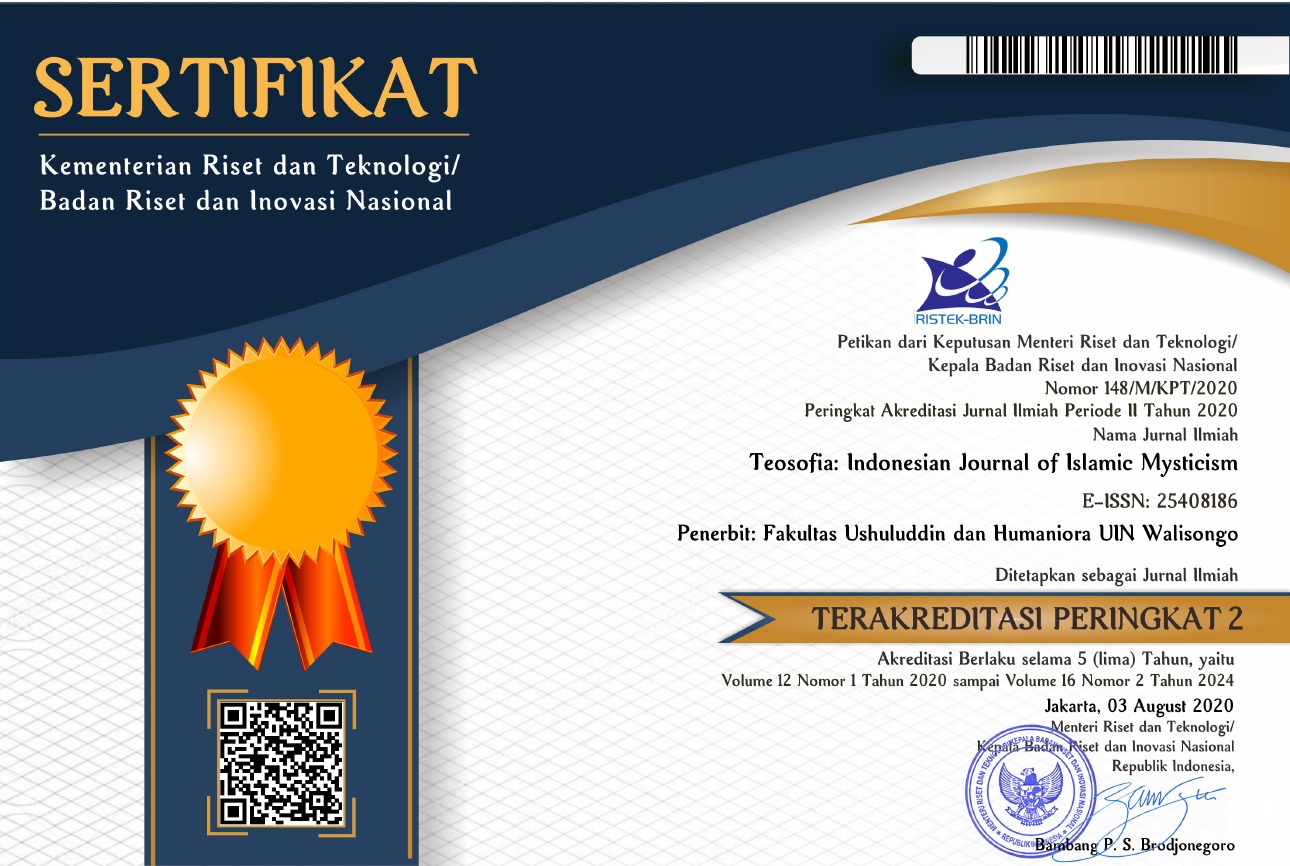Strategy and Effectivity of Sufi Healing as a Therapeutic Process for Curing Diseases
DOI:
https://doi.org/10.21580/tos.v12i2.18917Keywords:
sufi healing, physical and psychological Illness, Rehab Hati Foundation CirebonAbstract
Modern humans experience psychosocial stressors that affect physical and psychological health. This article discusses the strategy and effectiveness of Sufi healing on physical and psychological illnesses as practised at the Rehab Hati Foundation, Cirebon. This study used a phenomenological approach to understand the therapy process and strategy based on Sufi healing. Primary data were obtained from the leaders of the Rehab Hati Foundation, therapists, patients, and guidebooks used by therapists as references in treatment. This study revealed that the Sufi healing-based therapy uses the ruqyah method accompanied by thibbun nabawi (herbal medicine, honey, dates, etc.) and adapted to the disease experienced by the patient and also with spiritual advice. The ruqyah therapy techniques are two kinds, namely ruqyah therapy carried out directly by a therapist, and independent ruqyah therapy carried out by the patient himself or with the help of his family at home.
Contribution: This study provides a perspective that the treatment of human illnesses, both physical and psychological, is not only done medically based on medical science. Sufistic therapy, with ruqyah and thibbun Nabawi, can be an alternative to healing human illnesses.
Downloads
References
Alishan, Omar. Terapi Sufi. Yogyakarta: Pustaka Sufi, 2004.
Allen, Douglas. Phenomenology of Religion. London: Routledge, 2005.
An-Najr. Psikoterapi Sufistik Dalam Kehidupan Modern. Bandung: Mizan Publika, 2004.
Arikunto, Suharsimi. Prosedur Penelitian: Suatu Pendekatan Praktek. Jakarta: Rineka Cipta, 2010.
Arroisi, Jarman. “Spiritual Healing Dalam Tradisi Sufi.” Tsaqafah: Jurnal Peradaban Islam 14, no. 2 (2018). https://doi.org/10.21111/tsaqafah.v14i2.2459.
Chaplin, James P. Kamus Lengkap Psikologi. Jakarta: Raja Grafindo Persada, 1981.
Connolly, Peter. Approaches to the Study of Religion. London: The Continuum International Publishing Group, 1999.
Hawari, Dadang. Manajemen Stres Cemas Dan Depresi. Jakarta: FKUI, 2001.
Hubarman, Mattew B. Miles dan A. Michael. Qualitative Data Analysis; A Sourcbook of New Methode. Jakarta: Universitas Indonesia (UI-PRESS)., 1992.
Isnawan, Mohammad Rafi, and Muhammad Asrori Ma’sum. “Pemanfaan Sufi Healing Pada Era New Normal Pandemi Covid-19 Untuk Menajaga Kondisi Homeostasis Tubuh Masyarakat Di Desa Sendang.” IJoIS: Indonesian Journal of Islamic Studies 1, no. 01 (September 19, 2020): 77–94. https://doi.org/10.59525/ijois.v1i01.6.
Ivanishkina, Yulia Vyacheslavovna, Margarita Borisovna Shmatova, and Elena Antonovna Goncharova. “Sufi Healing in the Context of the Islamic Culture.” European Journal of Science and Theology 16, no. 5 (2020): 99–106. http://www.ejst.tuiasi.ro/Files/84/9_Ivanishkina et al.pdf.
Ma’sum, Muhammad Asrori, and Muhammad Nasrul Waton. “Implementasi Sufi Healing Pada Era New Normal COVID-19 Dalam Menjaga Kondisi Homeostatis Tubuh Masyarakat: Studi Analisis Di Desa Kayen Bandarkedungmulyo Jombang Jawa Timur.” Muróbbî: Jurnal Ilmu Pendidikan 4, no. 1 (March 31, 2020): 103–20. https://doi.org/10.52431/murobbi.v4i1.304.
Muhammad Fuad Abd al-Baqi. Al-Mu’jam Al-Mufahras. Cairo: Dar al-Hadits, 1996.
Mujib, Abdul. Teori Kepribadian; Perspektif Psikologi Islam. Jakarta: Raja Grafindo Persada, 2017.
Mulyana, Deddy. Metodologi Penelitian Kualitatif Paradigma Baru Ilmu Komunikasi Dan Ilmu Sosial Lainnya. Bandung: Remaja Rosdakarya, 2001.
Mustamir Pedak. Kerangka Konsep Sufi Healing. Malang: Literasi Nusantara, 2021.
O’riordan. Seni Penyembuhan Alami. Bekasi: PT. Gugus Press, 2002.
Pedak, Mustamir. Quranic Super Healing; Sembuh Dan Sehat Dengan Mukjizat Al-Qur’an. Semarang: PT. Pustaka Rizki Putra, 2010.
Saifuddin, Syamsul Bakri dan Ahmad. Fisik, Sufi Healing: Integrasi Tasawuf Dan Psikologi Dalam Penyembuhan Psikis Dan. Depok: Rajawali Pers, 2019.
Sanusi, M. Berbagai Terapi Kesehatan Melalui Amalan-Amalan Ibadah. Jogjakarta: Najah, 2012.
Selim, Nasima. “Learning the Elsewhere of ‘Inner Space’: The Affective Pedagogy of Post-Secular Sufi Healing in Germany.” Religion and Society 11, no. 1 (September 1, 2020): 105–19. https://doi.org/10.3167/arrs.2020.110108.
Sugiyono. Metodologi Penelitian Kualitatif Kuantitatif. Bandung: Alfabeta, 2018.
Sulaiman. Sufi Healing: Penyembuhan Penyakit Lahiriah Dan Batiniah. Semarang: Karya Abadi Jaya, 2015.
Syukur, Amin. Sufi Healing; Terapi Dengan Metode Tasawuf. Jakarta: Penerbit Erlangga, 2012.
Downloads
Published
How to Cite
Issue
Section
License
Copyright
The copyright of the received article shall be assigned to the journal as the publisher of the journal. The intended copyright includes the right to publish the article in various forms (including reprints). The journal maintains the publishing rights to the published articles. Therefore, the author must submit a statement of the Copyright Transfer Agreement.*)
Licensing

This work is licensed under a Creative Commons Attribution-ShareAlike 4.0 International License.
In line with the license, authors are allowed to share and adapt the material. In addition, the material must be given appropriate credit, provided with a link to the license, and indicated if changes were made. If authors remix, transform or build upon the material, authors must distribute their contributions under the same license as the original.
_______
*) Authors whose articles are accepted for publication will receive confirmation via email and send a Copyright Transfer Agreement.








